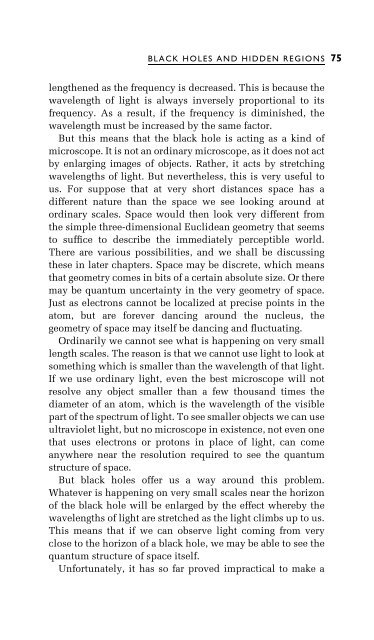Three Roads To Quantum Gravity
Three Roads To Quantum Gravity
Three Roads To Quantum Gravity
Create successful ePaper yourself
Turn your PDF publications into a flip-book with our unique Google optimized e-Paper software.
BLACK HOLES AND HIDDEN REGIONS<br />
75<br />
lengthened as the frequency is decreased. This is because the<br />
wavelength of light is always inversely proportional to its<br />
frequency. As a result, if the frequency is diminished, the<br />
wavelength must be increased by the same factor.<br />
But this means that the black hole is acting as a kind of<br />
microscope. It is not an ordinary microscope, as it does not act<br />
by enlarging images of objects. Rather, it acts by stretching<br />
wavelengths of light. But nevertheless, this is very useful to<br />
us. For suppose that at very short distances space has a<br />
different nature than the space we see looking around at<br />
ordinary scales. Space would then look very different from<br />
the simple three-dimensional Euclidean geometry that seems<br />
to suf®ce to describe the immediately perceptible world.<br />
There are various possibilities, and we shall be discussing<br />
these in later chapters. Space may be discrete, which means<br />
that geometry comes in bits of a certain absolute size. Or there<br />
may be quantum uncertainty in the very geometry of space.<br />
Just as electrons cannot be localized at precise points in the<br />
atom, but are forever dancing around the nucleus, the<br />
geometry of space may itself be dancing and ¯uctuating.<br />
Ordinarily we cannot see what is happening on very small<br />
length scales. The reason is that we cannot use light to look at<br />
something which is smaller than the wavelength of that light.<br />
If we use ordinary light, even the best microscope will not<br />
resolve any object smaller than a few thousand times the<br />
diameter of an atom, which is the wavelength of the visible<br />
part of the spectrum of light. <strong>To</strong> see smaller objects we can use<br />
ultraviolet light, but no microscope in existence, not even one<br />
that uses electrons or protons in place of light, can come<br />
anywhere near the resolution required to see the quantum<br />
structure of space.<br />
But black holes offer us a way around this problem.<br />
Whatever is happening on very small scales near the horizon<br />
of the black hole will be enlarged by the effect whereby the<br />
wavelengths of light are stretched as the light climbs up to us.<br />
This means that if we can observe light coming from very<br />
close to the horizon of a black hole, we may be able to see the<br />
quantum structure of space itself.<br />
Unfortunately, it has so far proved impractical to make a



![arXiv:1001.0993v1 [hep-ph] 6 Jan 2010](https://img.yumpu.com/51282177/1/190x245/arxiv10010993v1-hep-ph-6-jan-2010.jpg?quality=85)


![arXiv:1008.3907v2 [astro-ph.CO] 1 Nov 2011](https://img.yumpu.com/48909562/1/190x245/arxiv10083907v2-astro-phco-1-nov-2011.jpg?quality=85)








![arXiv:1002.4928v1 [gr-qc] 26 Feb 2010](https://img.yumpu.com/41209516/1/190x245/arxiv10024928v1-gr-qc-26-feb-2010.jpg?quality=85)
![arXiv:1206.2653v1 [astro-ph.CO] 12 Jun 2012](https://img.yumpu.com/39510078/1/190x245/arxiv12062653v1-astro-phco-12-jun-2012.jpg?quality=85)
